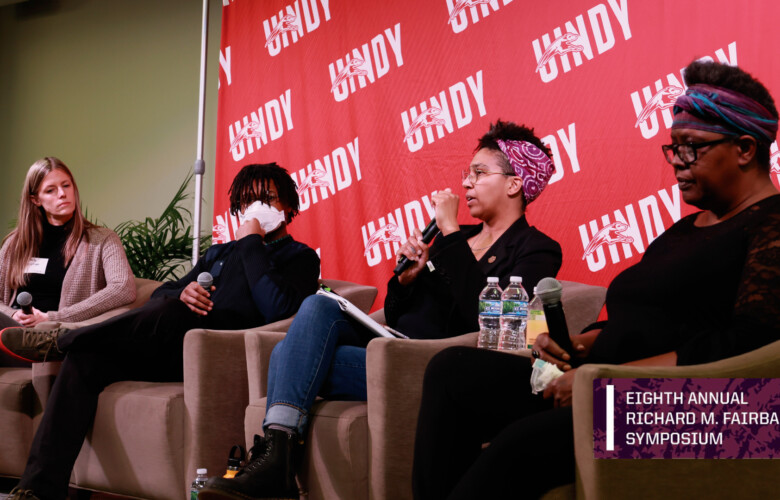Five things we learned during the 2023 Fairbanks Symposium: Environmental Justice in the Circle City
March 9, 2023Indiana Humanities and the University of Indianapolis both hope you had an engaging and inspiring experience discussing the past, present and future of environmental justice in Indianapolis. To reflect on…
Indiana Humanities and the University of Indianapolis both hope you had an engaging and inspiring experience discussing the past, present and future of environmental justice in Indianapolis. To reflect on your time at the symposium yesterday, here are five things we learned:
- There are many points in Indianapolis’s past that reveal histories of environmental injustice. During the first panel, Britt Redd pointed to Indianapolis’s redevelopment efforts of the 1940s, which paved the way for the city to build freeways through Black communities. Redevelopment destroyed the social fabric of those neighborhoods, thereby making collective activism difficult to achieve. Kaila Austin explained how oral histories of the Norwood community describe the shifting experiences of Black residents in the community. Originally a neighborhood populated by U.S. Colored Troop veterans of the Civil War, residents lived off the land until the Coke Plant was built in the early 1900s. From there, oral histories reveal the declining health and struggles of residents who lived in these unhealthy conditions. Mike O’Conner mentioned the White River as a key place where environmental racism can be seen in the history of the city. He mentioned that if the White River is seen as the “binding of [Indianapolis’s] book,” the River’s specific places, residents and treatment (such as sewage outflows) tell the story of our city’s environmental history.
- Preserving and knowing our history is necessary to achieving justice. Panelist Britt Redd made clear connections between our knowledge of the past and our efforts toward justice, pointing out that humans have short memories, but we can look to history to reveal patterns of injustice, disinvestment and unequal treatment. Knowing these histories can instill a sense of common struggle or community pride, as Kaila Austin pointed out, which can build support for a cause and activate community members. Stories are powerful conveners, bringing folks together to talk, learn and act.
- Keynote presenters Brian Payne and Denise Abdul-Rahman made it clear that civic leadership, especially when it comes to environmental justice, means letting communities lead—not creating solutions for community, but facilitating solutions designed with and by the communities directly impacted. Abdul-Rahman reflected on one of the biggest challenges facing Indiana when it comes to climate: the equitable transition to clean energy, including changes to our transportation system. Both speakers spoke to the realities of racism and white supremacy as it pervades all systems and discussed the many ways that organizations today are working through their histories to understand and dismantle these legacies of racism and oppression. University of Indianapolis’s Ted Frantz recalled the words of Ella Baker to close the symposium: “Strong people don’t need strong leaders.”
- Youth leadership in the environmental justice movement is not only an inspiration but integral to its success. During the last panel, Tatjana Rebelle discussed how working with youth has provided a sense of optimism for the future. When asked about their takeaways from working with young people, Rebelle specifically cited optimism, especially the indifference that youth have for negatively-impacting environmental policy and bureaucracy. Similarly, Chioh Mwaafrika took the time to address how public policy has affected him in his role as a youth leader, highlighting how detrimental political choices only inspire him to keep pushing forward.
- Envisioning a future based on environmental justice requires important conversations about power and how it is wielded. Panelist Paula Brooks reflected on her history with the movement, the progress that has been made and how that progress was achieved. Brooks reminded us that achieving a just environmental future requires important discussions about the nature of power (and who is willing to cede it). She suggested, “in order to have justice, the people who hold power have to share some of that power and learn to collaborate with their communities.”
Additionally, if you would like to learn more about environmental justice and find ways to get involved, consider checking out these websites:
- Climates of Inequality – Indianapolis
- The Chisholm Legacy Project
- Hoosier Environmental Council – Indiana Coal Ash Map
- Earth Charter Indiana
- Indianapolis Office of Sustainability
- Keep Indianapolis Beautiful
- Kheprw Institute
- Central Indiana Community Foundation
- Invisible Indianapolis: Race, Heritage and Community Memory in the Circle City
- IDEM: Air Quality: Real Time Data
- IDEM Water Quality Atlas


